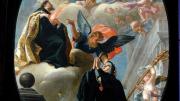Saint Gertrude of helfta, known as “The Great,” was given to the German convent of Helfta as a child of five to be reared as a nun, received her first vision of Christ’s “divine sweetness” in 1281 when she was 25, and became a spiritual counselor to whom people flocked for advice. But she was little remembered after her death until the Latin edition of her work was published in 1536 and she began to gain the extraordinary fame in Catholic religious circles that she enjoys to this day. Isidoro Arredondo’s late seventeenth-century painting (opposite) faithfully represents the widely diffused stereotype of Gertrude as an isolated figure pleading in eroticized ecstasy before the flaming heart of Jesus offered to her by a male mediator (possibly Saint Augustine).
This image of Gertrude the swooning mystic has been both propagated and criticized for centuries. To early twentieth-century students of the psychology of religion, Gertrude’s “absurd and puerile” visions were an example of what William James called “theopathic saintliness.” Protestant historians and some recent feminists have either condemned her for the implausibility of such visionary experiences as her alleged exchange of hearts with Jesus, or lauded her for an individualism that claimed direct access to divine grace, bypassing the clergy. Catholic writers have regularly seen in Gertrude and her sister nun Mechtild of Hackeborn the origins of the cult of the Sacred Heart of Jesus that became a popular Catholic devotion only in the seventeenth century.
None of this bears much relation to the historical figure of the Helfta nun. The Gertrude we know from the important work associated with her, the Herald of Divine Love, was not a lone individual, languishing in sickly and sexually sublimated ecstasy. Indeed, as the scholar Anna Harrison has recently emphasized, Gertrude was not so much an individual as a community.
Most of the prayers circulated under her name today are not by Gertrude at all. She wrote only some spiritual exercises and the second book of the Herald, which was supplemented by a first book (written after her death, probably by a fellow nun) and three more books of revelations, some of which appeared to other members of the convent or its secular friends. But if Gertrude was not the “author” of most of the great book attributed to her, she may well have been one of the two nuns who wrote down the other famous book associated with Helfta, the collection of revelations given to Mechtild of Hackeborn and known as The Book of Special Grace.
The fact that an entire community “authored” Gertrude’s works undercuts the picture of her as a lone, childishly needy mystic and forms the basis for a necessary reinterpretation of the spiritual teaching of Helfta. Gertrude’s visions were often about her community; those around her saw her primarily as teacher and adviser; and the spiritual teaching of book two of the Herald makes clear the priority of service of neighbor over the pleasure of private prayer. The nuns were neither anticlerical nor subconsciously resistant to patriarchy; respect for the clergy is underlined in several visions. Nonetheless, the collected revelations received at Helfta show a female and female-led community in which Gertrude is sometimes understood to take quasi-priestly roles.
Repeatedly, Christ—who appears to her most often as a cheerful baby or a handsome young man, not as the bleeding, agonized figure popularized in fourteenth- and fifteenth-century devotion—assures Gertrude that he will “certainly supply” whatever she promises in his name, even asserting, “I will speak through your mouth.” In revelation after revelation, this power is offered to Gertrude not, as William James would have it, to “comfort her undeserving person” but so her sisters might share in what Christ has given to all. Moreover, for all the apparent simplicity of the visions, the Herald evidences at moments an almost postmodern awareness both of the way in which accounts of inner experiences are invariably constructed in highly metaphorical language, not just recorded, and of the danger that a soul might mistake her own desires for God’s.
The visionary and communal spirituality found in the Helfta texts represents a turning point in Western culture. For the first time, scholars have enough material written by women to be able to demonstrate, by comparative analysis, that a particular kind of religious sensibility is more common among women than men. They can also document that the devotional emphases found in the visionary texts of female religious houses influenced male writers and practitioners. The years between 1200 and 1400 are thus the first point at which we can be sure that ideas and practices emanating from women’s institutions and women’s pens changed (for better or for worse) the broader culture.
But it is important to understand the spirituality of these women correctly. Whatever writers and theologians from the sixteenth century on may have made of the revelations of thirteenth-century nuns such as Gertrude, the women themselves espoused a kind of communal identity manifest in their commitment to a service of each other that extended even to writing each others’ works. A better image of Gertrude the Great than Arredondo’s languishing nun would be the kind of miniature that female scribes often inserted into their own prayer books: small, virtually identical, round-faced, and cheerful sisters gathering as a community around the Virgin Mary, who holds a cheerful and round-faced baby Christ.






